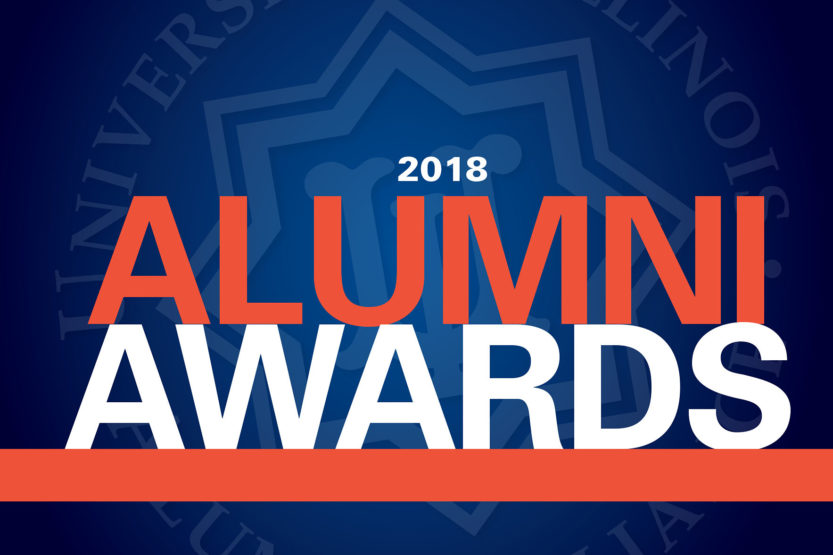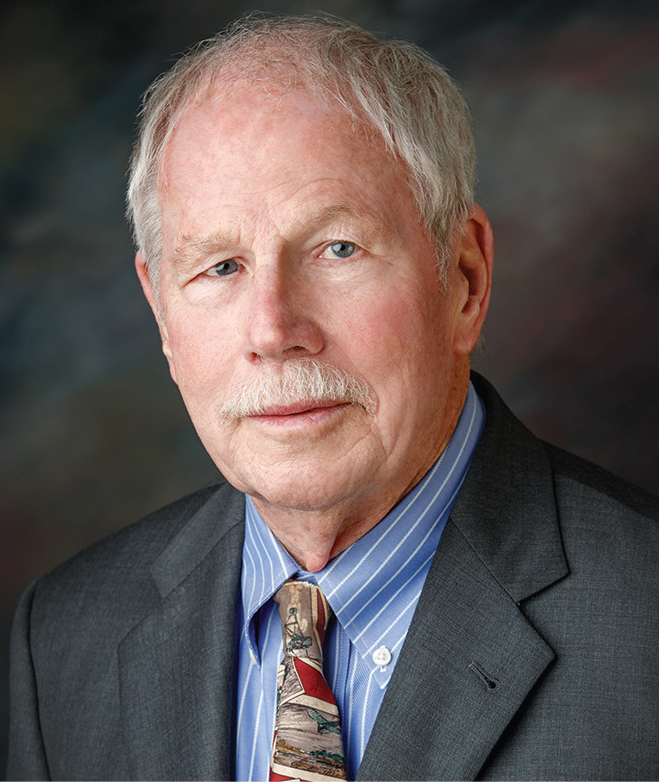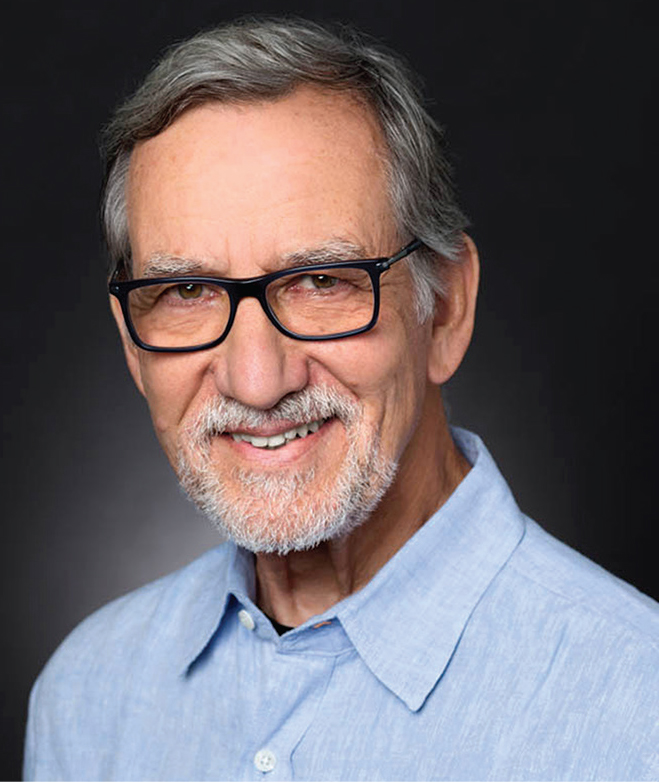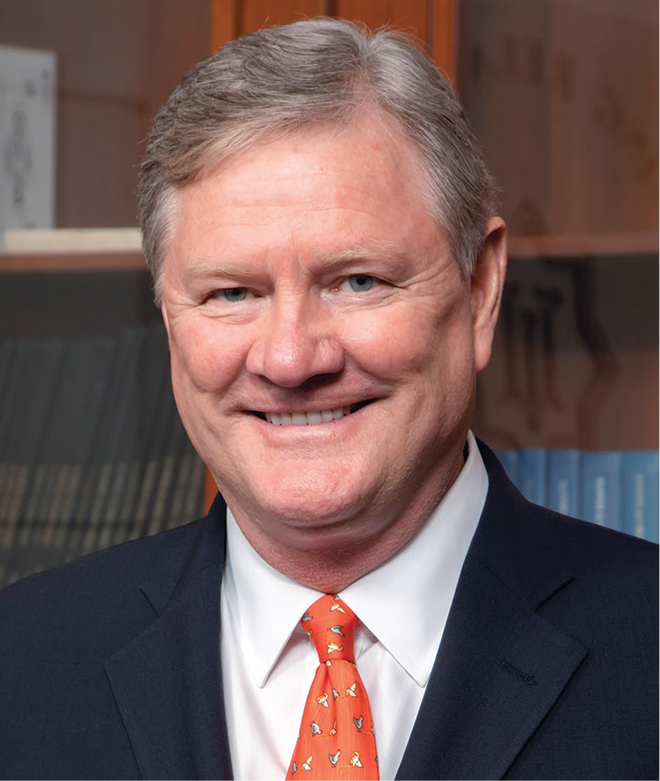2018 ALUMNI AWARDS

ALUMNI ACHIEVEMENT
HIGH FLYER
Aeronautical innovations of Bob Liebeck reshaped modern airplane design
Bob Liebeck, ’61 ENG, MS ’62 ENG, PHD ’68 ENG, loves making things go faster. He’s a world-class aerodynamics expert whose signature wing design has increased the lift and efficiency of high-speed aircraft. And while Liebeck is a brilliant scientist, he’s hardly a creature of the laboratory; much of his professional outlook was shaped by his two best friends—superstar race car driver Dan Gurney and World War II flying ace Russ Schleeh—and their long-running series of motorcycles races through the Southern California desert.
“I had these two close friends who were the most fiercely competitive people I’ve ever encountered,” recalls Liebeck. “We’d be out in the desert going as fast as we could, and I broke a few bones, but I learned that competition is everything. It taught me that whenever you do something, you do it with a wide-open throttle.”
Over the course of his 55-year career with The Boeing Co., Liebeck has helped transform commercial aviation. Using concepts he researched while a doctoral student at Illinois, he developed the Lie-beck airfoil, a wing design for high-lift aviation that is now an industry standard. But Liebeck didn’t start out with the perfectionist’s zeal that came to characterize his aeronautical engineering. As a young man, he was an indifferent student, not only in high school in Wheaton, Ill., but at North Central College in Naperville, Ill.
The Liebeck airfoil
At Illinois, Aeronautical Engineering Professor Allen Ormsbee convinced Liebeck to consider aircraft design—and to apply himself more fully. Liebeck’s turnaround was swift, and soon he was excelling in the classroom and making plans to move West after graduation to work in the aerospace industry.
But Ormsbee pleaded with him to stay and pursue a Ph.D. at Illinois instead. Liebeck agreed, after the professor offered a compromise: Liebeck could work over the summer at the Douglas Aircraft Company in California, and return to campus in the fall to enroll in UI’s graduate program in aeronautical and astronautical engineering.
The deal paid off for everyone: Liebeck worked at the company every summer until he earned his doctorate from Illinois, at which point he joined Douglas full-time. (The company would become part of Boeing after a series of mergers.)
His dissertation heralded the creation of the Liebeck airfoil, his now-famous wing design. (Liebeck and his wife Cindy established an aerospace professorship at Illinois in Ormsbee’s name in 2015.)
Liebeck chose airfoil design on the suggestion of Ormsbee, who flew sailplanes. Working backwards, Liebeck started with a target velocity distribution and fundamental, first-principle physics, to design an airfoil that met his design criteria. The resulting class of Liebeck airfoils went on to become an aeronautical legend.
In fact, the influence of the Lie-beck airfoil isn’t limited to aviation. “Once I got the method done, I found I could design airfoils for a lot of things,” Liebeck says. That included both race cars and sailboats—America3, a craft with a Liebeck airfoil keel, won the America’s Cup in 1992. And a Dan Gurney-owned car that included a Liebeck-designed wing won the Indy 500 in 1975.
Liebeck has directed Boeing’s Blended Wing Body (BWB) program for many years. Although he has handed over the administrative reins, he remains the program’s chief scientist. Boeing’s BWB transport planes are descendants of the flying wing planes first developed during World War II. The most famous flying wing aircraft is the Northrop Grumman B-2 Spirit—the “stealth bomber” used in the Gulf War.
The BWB concept forgoes the traditional tube-plus-wings aircraft shape in favor of a more integrated design, which promises substantial fuel-efficiency gains compared to conventional aircraft. Boeing and NASA have jointly and extensively tested BWB designs, and Boeing officials have indicated that a BWB aircraft could be in production within a decade.
Liebeck continues to devote 40 hours a week to the project, and he is sticking to his full-throttle mantra. In February, he arrived at his own 80th birthday party in a P-51 Mustang fighter plane.
“The main items on my bucket list have all been checked off,” Liebeck says. “Drive an Indy car, and fly in a P-51.”
Perhaps that’s true—but if Boeing’s Blended Wing Body plane becomes a reality, here’s betting that Liebeck won’t turn down a ride. —Steve Hendershot
ALUMNI ACHIEVEMENT
CELLULAR EXPERT
Jim Spudich’s multi-disciplinary work in biochemistry promises new treatments
Throughout his career, scientist Jim Spudich, ’63 LAS, has seen possibilities in surprising collaborations and unexpected observations. The renowned biochemist’s work focuses on identifying, understanding and manipulating the tiny, cellular motors that control such biological functions as muscle contractions. His life and career also have been studies in the power of forging new connections. Thanks to his knack for innovation, as well as his pioneering, interdisciplinary zeal, Spudich has opened new research pathways that may one day yield treatments for medical conditions such as ALS and cardiovascular disease.
“I’ve tried to take chances both in my scientific career and in my personal life,” says Spudich. “Because it’s a complicated combination of factors that leads to success.” That he has indeed found success is evident in the numerous accolades he has received, including the 2012 Albert Lasker Award for Basic Medical Research (a.k.a., “America’s Nobel Prize”). Spudich has spent most of his academic career at Stanford University, where he is the Douglas M. and Nola Leishman Professor of Cardiovascular Disease.
A multidisciplinary start
Spudich grew up amid many changes. He was born in tiny Benld, Ill., to a family of Croatian immigrants. His father worked in a coal mine, and Jim would often walk with him along the railroad tracks to the entrance of the mine. When Spudich was 5, his younger sister developed a heart condition, and the family moved to Arizona in hopes that the arid climate would heal her. It worked, at least for a while, and the family spent five years in Phoenix, during which time Spudich attended three different schools. His sister died when he was 10, and the family relocated again, first to Missouri and then to Granite City, Ill., in a 700-square-foot house. Despite the cramped quarters, Spudich’s parents converted the pantry into a chemistry lab where he and his brother could conduct studies and experiments.
At Illinois, Spudich aced an early chemistry test, and was invited to join a handful of other freshmen in an advanced class. He hadn’t given much thought to his eventual discipline, biochemistry, until a friend invited him to have lunch with John Woodland “Woody” Hastings. The young assistant biochemistry professor was so impressive that Spudich immediately cancelled his summer internship in an organic chemistry lab and went to work with Hastings instead. “He was just so convincing and full of energy; it was captivating,” Spudich recalls.
Hastings ran his lab with a multidisciplinary approach that was uncommon in that era. “He was way ahead of his time, because in those days you were either a chemist or you were a biologist or a geneticist or a structural biologist, but you weren’t all of those things,” Spudich says. “The only place that would happen was in Woody’s lab.”
Spudich earned his Ph.D. in biochemistry from Stanford in 1968 and accepted a faculty post there in 1971. His research led him to the study of molecular motors and how to isolate their functions. In 1986, he and a graduate student demonstrated that a movement akin to muscle contraction could be instigated using just two of the 5,000 proteins in a human cell. A decade later, Spudich collaborated with a Stanford colleague, physicist Steven Chu, to isolate the individual filament movements of those two proteins, actin and myosin. Graduate students from Spudich’s lab worked with Chu to build a “laser trap” capable of isolating the tiny proteins.
In 1998, Spudich became the inaugural director of Bio-X, a Stanford research center that remains a national leader in bioscientific collaboration. Around the same time, he had a revelation: His research not only revealed biological processes, but also had the potential to solve serious medical problems. He co-founded Cytokinetics, a biotechnology company, to develop muscle activation therapies that target diseases such as ALS. In 2012, Spudich went on to co-found MyoKardia, a precision-medicine company that aims to translate his research into products that combat neglected and rare cardiovascular diseases.
“It seems like a different world and a different life altogether,” Spudich says of his childhood in Benld. “If you follow your interests and have the guts to take chances and try things, then who knows where you’re going to go?”—S.H.
DISTINGUISHED SERVICE
ANGEL INVESTOR
Financier Mike Tokarz is devoted to the university’s betterment
Mike Tokarz, ’71 LAS, MBA ’73, can pinpoint the moment he knew that the University of Illinois was the place he wanted to be. In his junior year at Fenton High School in his hometown of Bensenville, Ill., Tokarz turned down an invitation to play in the state championship golf tournament. He opted instead to attend the Illinois Junior Academy of Sciences exposition, which was being held on the UI campus. He presented his project, a study of bacteria in plants, and received guidance and encouragement from the professors judging the competition.
“The experience was life-changing,” he says. “Being a high school student making my first trip to Illinois with my science teacher and fellow students was extraordinary.”
Tokarz went on to receive degrees in economics and business administration, and to achieve resounding business success in the world of finance. But even though his talent and ambition were clear from the start, no one could have anticipated the return on investment that his enrollment would mean for the University.
A seasoned financial executive, Tokarz is founder of The Tokarz Group, a private merchant bank, and he is a co-founder of Public Pension Capital, a private equity firm. Over the years, he has contributed extensive time, energy and financial resources to the University, serving in key roles with the University of Illinois Foundation and on special projects. The 50-year relationship between Tokarz and his Alma Mater has been one of steadily compounding interest, marked by mutually beneficial gains.
Financial Innovation
Tokarz joined Continental Illinois National Bank and Trust Company of Chicago in 1973. He went on to become vice president and manager of Continental’s New York and Eastern Regional offices, and developed a reputation for innovation in financing and corporate buyouts. In 1985, Tokarz joined Kohlberg Kravis Roberts & Co., a private equity firm that specializes in corporate buyouts. Over a 17-year career with KKR, he rose to the positions of general partner and administrative partner.
Tokarz left KKR in 2002 to found The Tokarz Group. That same year, he also played a pivotal role in the creation of Illinois VENTURES, an investment capital fund established by the University Board of Trustees to identify, evaluate and launch research projects by UI faculty and students that show potential for becoming commercially successful business start-ups. Illinois VENTURES provides seed funding for selected projects, then raises additional capital from private investors—more than $1 billion so far, according to Avijit Ghosh, UI System vice president and CFO.
Ghosh says of Tokarz, “The time and energy he invests in the University is prodigal—rooted in his interest in the current and future generations of students. His passion and commitment to the Institution is inspiring.”
Giving back to Illinois
In 2005, Tokarz stepped up to co-chair a capital campaign to build the UI Business Instructional Facility and double the endowment of the College of Business (now Gies College of Business) at Illinois. Tokarz personally contributed $7.5 million toward the campaign’s $75 million goal. He has served on the UI Foundation Board of Directors, chairing key financial and investment committees, and has been named a life director of the Foundation.
Business Dean Jeff Brown describes him as “a steady and wise external advisor, someone with a brilliant mind, a deep understanding of finance and an intense love for the University.”
Tokarz was inspired by, and stayed in touch with, the late business professor Paul Magelli, ’59 LAS, MS ’60 BUS, PHD ’65 BUS, whom he describes as “one of the most special people I ever met.”
Tokarz says that when he returns to campus, “There are special places I visit—places where I have memories created at the time I was a student. Some are well-known like the Union, the Alma Mater and the football stadium. I also have secret places where I talk to myself about what my life was then, is now, will become and how it may be looked upon.
“The experience I had as a student and being a part of the leadership team at the Foundation—it’s an essential part of my life,” Tokarz concludes. “A large part of who and what I am is because of the University of Illinois. The University is in my heart, my soul, my bloodstream.”—Paul Engleman




